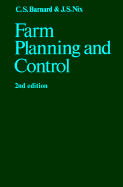Book contents
- Frontmatter
- Contents
- Notice to readers
- Preface to the first edition
- Preface to the second edition
- Selected metric conversion factors
- Part I The organisation of resources
- Part II The organisation of enterprises
- Part III The combination of enterprises
- 13 Principles and procedures in planning enterprise combination
- 14 Budgeting and programme planning
- 15 Linear programming
- 16 Uncertainty and farm organisation and planning
- 17 Further programming techniques
- 18 Matrix construction
- Part IV The control of resources and enterprises
- Selected further reading
- Index
14 - Budgeting and programme planning
Published online by Cambridge University Press: 01 June 2011
- Frontmatter
- Contents
- Notice to readers
- Preface to the first edition
- Preface to the second edition
- Selected metric conversion factors
- Part I The organisation of resources
- Part II The organisation of enterprises
- Part III The combination of enterprises
- 13 Principles and procedures in planning enterprise combination
- 14 Budgeting and programme planning
- 15 Linear programming
- 16 Uncertainty and farm organisation and planning
- 17 Further programming techniques
- 18 Matrix construction
- Part IV The control of resources and enterprises
- Selected further reading
- Index
Summary
Budgeting
Budgeting is the most widely used method of farm planning. In some ways, however, it is better described as an aid to, rather than a method of, farm planning. Other techniques described in this book offer means of selecting a farm plan. In budgeting, a farm plan is drawn up using a combination of experience, judgement and intuition; the process of budgeting itself is used only in evaluating the farm plan in financial terms. It could be argued that this is only a method of farm planning comparable with other techniques if more than one plan is drawn up for the farm and budgeting is used to help decide which to choose.
In this chapter budgeting is described mainly in relation to assessing annual profitability, that is, the expected effect on the trading account (see Chapter 19). This is in contrast to capital budgeting, in which the total required to implement a change of plan, or a complete new plan, is estimated; this procedure has already been described, in Chapter 3, pp. 53–6. The two effects can be combined to forecast changes over time in the balance sheet (see Chapter 20).
Budgeting may be defined as the detailed quantitative statement of a farm plan, or a change in farm plan, and the forecast of its financial result. It sets out (a) the physical aspects of the plan: what to produce, how much, and the resources needed, and (b) the financial aspects of the plan: the expected costs and returns and, therefore, profit. The term ‘farm budget’ is often used, however, solely, in regard to (b).
- Type
- Chapter
- Information
- Farm Planning and Control , pp. 314 - 352Publisher: Cambridge University PressPrint publication year: 1980



